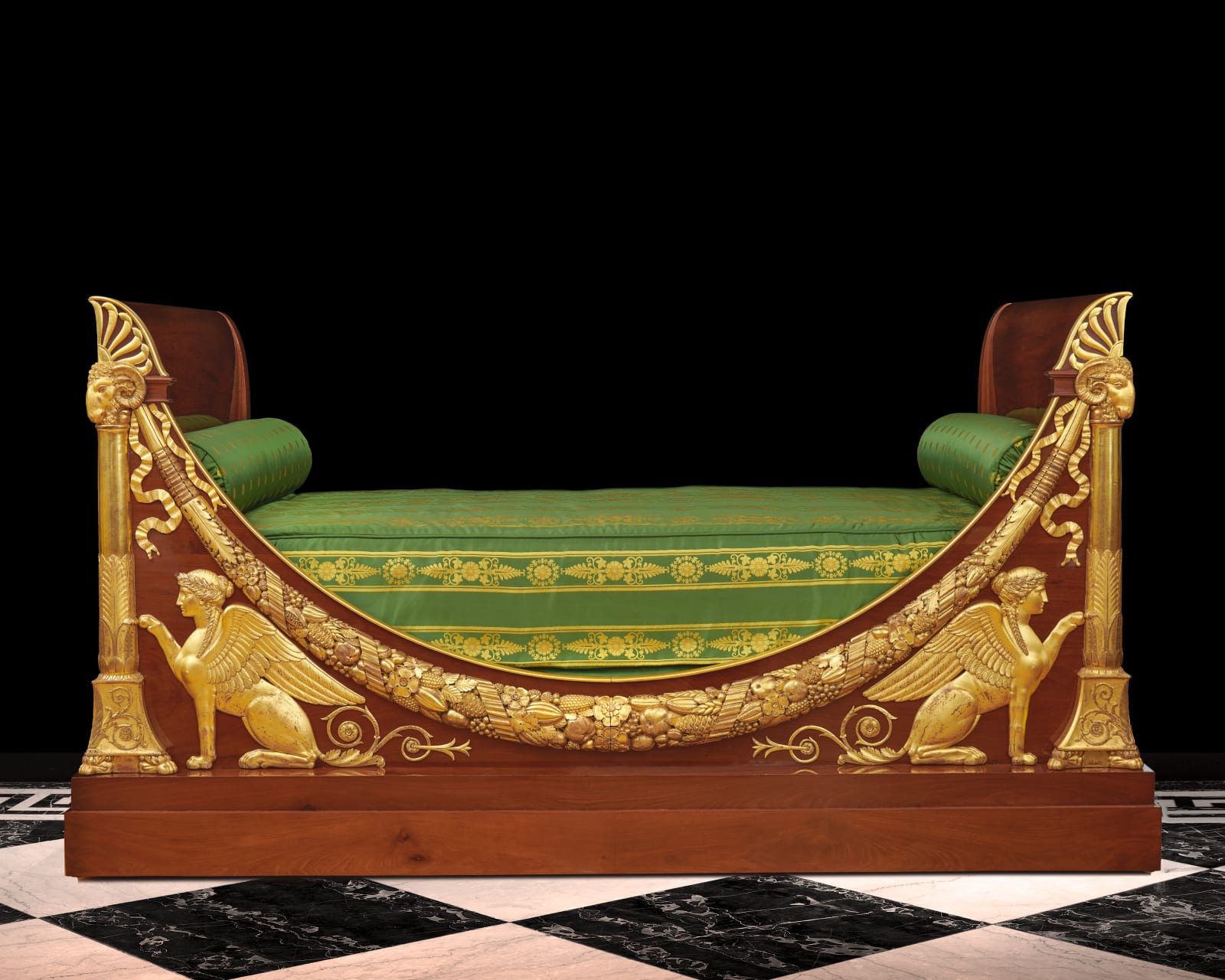
Charles Percier and Pierre François Léonard Fontaine, “Recueil des Décorations Intérieurs”, 1812 edition, pl. 60, illustrating a design for a bed for Monsieur Oz à Paris, of almost identical design.
Jacob Frères
Further images
-
(View a larger image of thumbnail 1
)

-
(View a larger image of thumbnail 2
)

-
(View a larger image of thumbnail 3
)
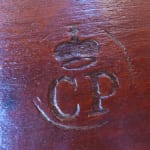
-
(View a larger image of thumbnail 4
)
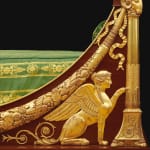
-
(View a larger image of thumbnail 5
)

-
(View a larger image of thumbnail 6
)
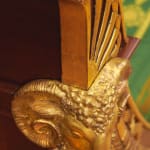
-
(View a larger image of thumbnail 7
)

-
(View a larger image of thumbnail 8
)
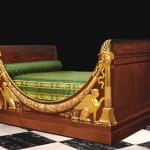
-
(View a larger image of thumbnail 9
)

Provenance
Delivered circa 1807/8 by Jacob-Desmalter et Cie to the Palais de Compiègne for l’appartement double de Prince, where it remained until 1858 when sold by the Garde-Meuble Impérial.
At that stage most probably acquired by a member of the Rochefoucauld family.
Later in the collection of the marquis and marquise de Amodio y Moya, at their Paris mansion at 93 rue de l’Université (historic home of the Rochefoucauld family), until it was recently sold as part of the marquis de Amodio y Moya’s deceased estate.
Literature
Richard Redding Antiques Ltd, "The Emperor Napoleon's bed at Palais de Compiègne" (see "Catalogues" on this website.)
Charles Percier and Pierre François Léonard Fontaine, “Recueil des Décorations Intérieurs”, 1812 edition, pl. 60, illustrating a design for a bed for Monsieur Oz à Paris, of almost identical design.
A rare and highly important carved and partially gilded Directoire lit en bateau by Jacob Frères which was delivered circa 1807/8 by Jacob-Desmalter et Cie to the Emperor Napoleon’s residence at Palais de Compiègne for l’appartement double de Prince,bearing numerous inventory stamps for the Imperial palace including one numbered C 1459 (for 1817) as well as further numbering in chalk C 5668. The front of the bed with ornate gilt painted carvings featuring at either end a lotus crest above an outward facing ram’s head capital upon a columnar support, each of which is wrapped with anthemion and acanthus leaves to the lower part and is supported on a splayed base ornamented with foliate sprays on lion paw feet, suspended from each of the ram’s heads is an abundant ribbon-tied swag carved with flower heads, pine cones, seed pods and fruit above a beautiful pair of carved winged sphinxes, each wearing a laurel wreath in her hair and having a foliate tail with one paw raised to touch the adjacent outer columnar support, the whole on a plain rectangular base, fitted underneath with its original wooden rollers (repositioned during the early nineteenth century) so that it could easily be moved when necessary
Paris, date 1800
Height 78 cm, length 215 cm, width 130 cm.
The importance of this outstanding bed cannot be overstressed. Not only is it of the very finest quality, having been made by Jacob Frères, the leading ébénistes of their day, almost certainly after a design by Percier and Fontaine but it was then delivered in circa 1807/8 to the Emperor Napoleon for his newly renovated Palais de Compiègne. There it was placed in l’appartement double de Prince where it was slept upon by many members from the imperial and royal families. The bed remained at Compiègne until 1858, when it was most probably purchased by either comte Hippolyte de la Rochefoucauld (1804-93) or his son comte Aimery de la Rochefoucauld (1843-1920) for their family Paris mansion in rue de l’Université. That supposition is based on the fact that the bed was later owned by Aimery de la Rochefoucauld’s granddaughter Anne marquise de Amodio y Moya (1906-80) who lived in the Rochefoucauld mansion in rue de l’Université with her husband Jean, marquis de Amodio y Moya (1909-2003).
Before describing the bed’s design and its creators it is worth expanding upon its illustrious provenance. Information concerning its early history has been kindly provided by Marc Desti, Conservateur en Chef, Palais impérial de Compiègne, to whom the Richard Redding Gallery is indebted. In particular M. Desti cites the most prestigious figures who would have used the bed as well as references to it among the Compiègne archives. It was listed in the inventory of 1809 (with no number) and thereafter regularly mentioned and described in successive inventories: C.1271 (1811), C.1459 (1817), C.1113 (1834), C.1163 (1848), C.1043 (1855) until its removal in 1858.
Dating from the mid eighteenth century, the Palais or Château de Compiègne was built on the site of a former royal hunting lodge. Since hunting was a passion of Louis XV he commissioned the architect Ange-Jacques Gabriel to enlarge it into an impressive Neo-classical residence; work began in 1751 and was completed 1788 by Gabriel’s student Louis le Dreux de la Châtre. During the French Revolution, the château passed into the control of the Ministre de l’Intérieur. In 1795 all the furniture was sold and its works of art were sent to the Muséum Central. Napoleon visited Compiègne in 1799 and again in 1803, the year before it became an imperial domain. Marc Desti cites 12th April 1807 as the beginning of the restoration at Compiègne. Napoleon entrusted the work to the architect Louis-Martin Berthault (1771-1823), with whom he drew up a project for an ‘appartement double de Prince’, by uniting the former apartment of the dauphin and that of Madame Royale. Napoleon had planned to hunt at Compiègne in September 1807 as evidenced by a note sent on 3rd August 1807 by the Grand Maréchal to Desmazis, the administrateur du Mobilier Impérial, in which he asked the latter to furnish the living area of the palace ‘either permanently or temporarily, but so that the furniture we send would remain there forever’. In a letter of 18th October of the same year addressed to comte Daru, intendant général de la Maison de l’Empereur, it is noted that Desmazis was to hastily prepare ‘deux appartements provisoires pour l’Empereur et l’Impératrice’ which the next year were destined to become ‘deux appartements de Princes’. Whilst Berthault and subsequently Percier and Fontaine were responsible for the architectural work at Compiègne, the artists Anne-Louis Girodet, Dubois and Pierre-Joseph Redouté were responsible for the painted decoration while Jacob-Desmalter and Pierre-Benoît Marcion supplied the furniture.
As Marc Desti notes, the occupants of l’appartement double de Prince were prestigious. Among them was Napoleon’s brother Jérôme Bonaparte, King of Westphalia (1784-1860) and his wife Princess Catherine of Württemberg who stayed there in 1810 for Napoleon’s second marriage to Marie-Louise and afterwards, from 14th November 1813 to 10th January 1814, when they were driven into exile. Jérôme once more occupied the apartment forty years later in 1853, during the reign of his nephew Napoleon III. During the years of the Bourbon restoration Compiègne frequently played host to visiting royalty. Among occupants of l’appartement double de Prince was Charles X’s son, Charles, duc de Berry (1778-1820) and his wife Marie-Caroline de Bourbon-Siciles, duchesse de Berry (1798-1870) as well as Charles X’s eldest son Louis, duc d’Angoulême (1775-1844) and his wife Marie Thérèse of France, duchesse d’Angoulême (1778-1851) - the eldest child of King Louis XVI and Marie-Antoinette. After the death of Louis XVIII in 1824, the usual occupants of l’appartement double de Prince changed. The duchesse de Berry, by now a widow, stayed in the appartement de la Reine while the duc and duchesse d’Angoulême occupied the former appartement du roi de Rome and part of the l’appartement double de Prince. During the Second Empire, the apartment was split into three parts under the designation apartment B1, B2 and B3, assigned to particularly important guests. They included Prince Napoleon Bonaparte (1822-1891) who, like his father Jérôme Bonaparte and his sister Mathilde, occupied l’appartement double de Prince during his stays at Compiègne.
After 1856, when Napoleon III and his wife Eugénie made Compiègne their autumn residence, many of the rooms were redecorated and as part of the grand refurbishment much of the existing furniture was removed by the Garde-Meuble. The present bed was amongst those pieces and, like others from the ancient palace, it was sold. When in 1988, many of the pieces of furniture from the Premier Empire period were restored, it was noted that in place of the present bed, stood a similar piece, made of mahogany with double columns from the workshops of the École de Châlons (the ancient École des Arts et Métiers that occupied the Château de Compiègne from 1800 to 1806). Made in 1815, it was delivered to the Tuileries in 1820 for the duchesse de Berry, who used it until 1824.
Although it is uncertain as to who exactly acquired the present bed after it left Compiègne, it can be assumed that it was a member of the Rochefoucauld family since we know that more recently it belonged to Jean, marquis de Amodio y Moya and his wife Anne, marquise de Amodio née de la Rochefoucauld and was housed at their Paris mansion at 93 rue de l’Université. As noted this was the former home of Anne de Rochefoucauld’s great grandfather comte Hippolyte de la Rochefoucauld and later her grandfather comte Aimery de la Rochefoucauld. It is therefore very likely that the latter once owned the bed and thereafter it remained in the Rochefoucauld family home until it was recently sold by the executors of the marquis de Amodio y Moya who died in 2003. Included in that sale were a number of other very fine pieces of Directoire and Empire furniture and works of art.
The Rochefoucauld’s Paris mansion in rue de l’Université, is and was a graceful building boasting numerous rooms facing the Hôtel de Lassay, the President’s palace and l’Assemblée Nationale. It was built in the mid nineteenth century as an extension to the Rochefoucauld family’s eighteenth century residence (now Maison de la Chimie), situated in rue Saint-Dominique, which runs parallel with the rue de l’Université. When the comte Aimery de la Rochefoucauld and his wife Henriette née Mailly Nesle (1852-1913) lived in rue de l’Université, their home became famed for its elegant parties. Their many guests belonged to the cream of French aristocracy; another frequent visitor was the writer Marcel Proust whose description of the Salon de comtesse Aimery de Rouchefoucauld not only commented upon her beauty, wit and grace but also the number of paintings that lined the mansion’s numerous rooms. Marcel Proust also featured in his novels the comte and comtesse’s son - comte Gabriel de la Rouchefoucauld (1875-1942) and his wife Odile Chapelle de Jumilhac (1879-1974). They were also the next occupants of the family residence at 93 rue de l’Université. Odile Chapelle de Jumilhac was the daughter of the French aristocrat Marie Odet Richard Armand de La Chapelle de Jumilhac, duc de Richelieu (1847-1880) a Marie Alice Heine (1858-1925). The latter was a fascinating woman who, like her cousin the famous writer Heinrich Heine (1798-1856), came from a wealthy banking family. Born in 1858 in New Orleans, Marie Alice Heine went to France aged 16 and having been introduced to Parisian society, she married the duc de Richelieu in 1875. In 1889, nine years after the latter’s death, she married Albert I Grimaldi, Prince of Monaco (1848-1922). As Princess of Monaco, she devoted herself entirely to the Principality and in particular promoted its opera, theatre and ballet as a cultural centre under the direction of Sergei Diaghilev.
The next occupants of the Paris mansion in rue de l’Université and owners of the present bed were Gabriel and Odile de la Rochefoucauld’s daughter Anne and her husband Jean de Amodio y Moya, who married one another in 1948. The marquis and marquise de Amodio y Moya were great philanthropists and for many years were involved in special aid projects for the elderly, the mentally and physically disabled as well as the preservation of cultural heritage. The marquis, who studied at Stowe School and then Oxford University, was a keen sportsman. He proved to be one of the best fencers of his generation and was also a very adept rider. After graduating from Oxford, he led an expedition to Lapland in the winter of 1937. During WWII he was among those who landed in Normandy in June 1944 and later that year contributed to the liberation of Paris and subsequently Brussels. In 1946 he became squadron leader and assistant to H.M.’s Air Attaché to the British Embassy in Paris. Cultural heritage was among the main concerns of the marquis and marquise who in 1958 established an association for the preservation of historic buildings Vieilles Maison Française which they ran from their home in rue de l’Université. Following the death of his wife in 1980, the marquis established the Anne de Amodio Prize of the International Burgen Institut, to award those that had sympathetically restored an historic building. In addition the marquis was an Honorary Fellow of the Ancient Monuments Society and Fellow of both the Royal Geographical Society and the British Interplanetary Society. He also contributed greatly to politics, security, and the building of post-war Europe as founder-chairman in 1952 of the Royal Air Forces Association’s European Area Council, of which he became President in 1967 and Life President in 1991 as well as being made life Vice-President of the Royal Air Forces Association, 1962. Other awards included a Gold medal from the Société d’Encouragement au Progrès, being appointed an officer of the French Légion d’honneur in 1945, an O.B.E in 1962 followed by a C.B.E. in 1996. Furthermore he was made a Knight Commander of the Order of the Holy Sepulchre and Commander of the Yugoslavian Royal Order of the White Eagle.
The bed’s importance not only rests upon its illustrious provenance but also that it was made by the very finest Paris ébénistes Jacob Frères. They were responsible for the superb carvings, which in turn were almost certainly modelled on designs by Napoleon’s foremost architects and ornemanistes Charles Percier (1764-1838) and Pierre François Léonard Fontaine (1762-1853). The design is typical of the Directoire period, which took as its main inspiration the arts of classical antiquity but also often that of ancient Egypt, as exemplified here. Indeed the striking sphinxes and stylised lotus mounts reflect the goût Égyptien that prevailed during the first years of the nineteenth century. Such interest in the ancient lands of the Pharaohs, sphinxes and pyramids had existed long before but gained renewed momentum after Napoleon’s Egyptian campaigns and particularly when in 1798 he took a group of artists and scientists to record the many wonders along the banks of the Nile.
Foremost amongst artists and designers to promote the goût Égyptien were Percier and Fontaine, whose book of designs “Recueil des Décorations Intérieurs”, first published in 1801, included a number of pieces of furnishings and interiors that reflected both the taste for ancient Egypt as well as that of classical antiquity. Included in their publication is a bed designed for M. Oz à Paris (pl. 60) which is almost identical to the present example in that the two ends are headed by lotus crests above foliate-wrapped columns with ram’s head capitals, from which is suspended an abundant ribbon-tied swag; however in place of the two sphinxes below, Monsieur Oz’s bed features a male and female figure seated above a more ornate base. Similar sphinxes appear elsewhere in their book of designs, for instance surmounting a clock for ‘C.G. en Espagna’ (pl. 8) as well as those adorning a jardinière or table à fleurs (pl. 10). In addition ram’s heads along with various Egyptian motifs are integrated within decorations for another bed (pl. 15), which interestingly is noted as having been designed for Jacob Frères. In other instances, Percier and Fontaine feature very similar columnar supports, for instance for a lamp for the ‘atelier de peinture du CI’ (pl. 4), while a clock intended to be surmounted by a bust (no. 4 of pl. 38) features a comparable ribbon-tied swag suspended from ram’s heads. Such close comparisons leave one in no doubt that Percier and Fontaine were responsible for the present design.
As leaders in their fields Jacob Frères, later known as Jacob-Desmalter, often made overt reference to the retour d’Égypte as evidenced by one of a Jacob Frères’ mahogany table de chevet with giltwood sphinx supports (illustrated in Denise Ledoux-Lebard, “Le Mobilier Français du XIXe Siècle”, 1989, p. 278). Likewise the firm often used designs supplied by Percier and Fontaine. All of their pieces were of the very highest quality, most of which was of polished mahogany, sometimes as here with partial gilding or decorated with gilt bronze mounts; occasionally they featured lighter woods such as satinwood inset with ebony or even mounted with porcelain plaques.
The partnership of Jacob Frères at rue de Meslée, Paris was short lived but notable. The firm had been founded by Georges Jacob (1739-1814), the greatest menuisier of the Louis XVI period. Following his retirement in 1796, he handed control over to his two sons Georges II (1768-1803) and François-Honoré-Georges Jacob (1770-1841), who worked under the name of Jacob Frères. Although the collaboration between the two brothers was curtailed by the sudden death of George II ( who was mainly responsible for the business’s administration) during their short partnership they produced works of exceptional quality, elegance and innovation. As here the new decorations ‘à l’égyptien’ or ‘à l’antique’, perfect execution and the use of best mahogany were trademarks of their work. As evidence of their innovation and finesse, Jacob Frères received many major commissions from the Emperor – so much so that later when exiled on St. Helena he recalled the horrendous bills from Jacob Frères. In addition to Napoleon and particularly his first wife Josephine, other of Jacob Frères’ more important clients included M. Mars as well as Madame Recamier (whose furnishings can be seen in Jacques-Louis David’s famous portrait of her in the Musée du Louvre). When showing their work at the Expositions des Produits de l’Industrie Française, the brothers always received the highest honours, winning a gold medal in both 1801 and 1802.
The following year they were commended in L’Moniteur (an official government magazine) when the Ministère de l’Intérieur visited their workshops. Today one can admire the work of Jacob Frères in a number of public collections including the Musées des Arts Décoratifs, de Marmottan and Nissim de Camondo in Paris, the Chateaux de Fontainebleau, Rambouillet and Malmaison as well as the Wrightsman Collection in the Metropolitan Museum, New York. Following the death of Georges II in 1803, his brother, who added the suffix Desmalter (named after one of his father’s properties in Burgundy), went back into business with their father and renamed the firm Jacob-Desmalter et Cie. The firm’s activities expanded enormously following Jacob-Desmalter’s appointment as ébéniste de l’Empereur and it was at that period that this magnificent bed, along with other fine pieces of furniture, was delivered to the Emperor for the Palais de Compiègne

